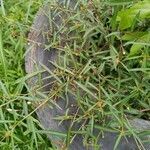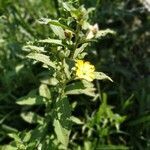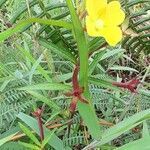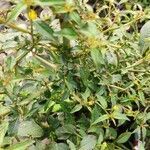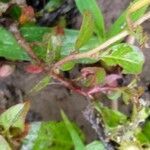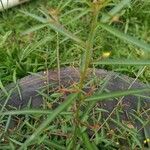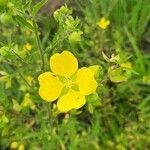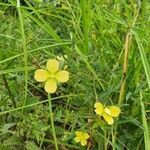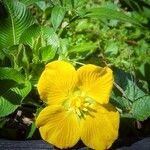Herbs robust, erect, perennial, sometimes woody at base or even shrubby. Stems 25-400 cm tall, well-branched, densely spreading pubescent at least on upper stem, or puberulous or subglabrous. Petiole 1-10 mm; leaf blade linear to subovate, 1-14 × 0.3-4 cm, lateral veins 11-20 per side, submarginal vein prominent, base narrowly or broadly cuneate, apex attenuate. Sepals 4, ovate or lanceolate, 6-15 mm. Petals yellow, broadly obovate, 6-17 × 5-17 mm. Stamens 8; filaments 1-4 mm; anthers 1.2-4 mm; pollen in tetrads. Style 1.5-3.5 mm; stigma subglobose, shallowly 4-lobed. Capsule pale brown with 8 darker ribs, cylindric, terete, 1.7-4.5 cm, 2-8 mm in diam., thinly walled, readily and irregularly loculicidal; pedicel 1-10 mm. Seeds in 2 or more rows per locule, free, brown, 0.6-0.75 mm, raphe inflated and equal in size to seed body, evenly transversely ridged. Fl. and fr. Jan-Dec. 2n = 32, 48*.
Robust, branching herb to 4 m high, sometimes woody at base, hirsute to subglabrous. Leaves alternate, narrowly linear to subovate, 1–15 cm long, attenuate, cuneate at base; subsessile or with petiole to 2 cm long. Flowers solitary in upper leaf axils; bracteoles often setaceous, on ovary base or upper pedicel, frequently reduced or absent. Sepals 4, obovate to narrowly so. Petals 1–2 cm long, occasionally more, yellow. Stamens 8. Capsule terete, 2–4.5 cm long, readily and irregularly dehiscent. Seeds in each locule in several rows, free.
Robust, well-branched herb, 0.04-4.00 m high; plants densely pubescent to subglabrous. Leaves ovate, 11-20 main veins on each side of midrib. Flowers solitary in leaf axils. Sepals 4; up to 15.0 x 7.5 mm. Petals up to 17 x 17 mm. Stamens 8; pollen shed in tetrads. Fruit a subterete capsule, up to 45 mm long, longitudinally 8-ribbed, pale brown, readily loculicidal; pedicels up to 10 mm long. Seeds up to 0.75 mm long, brown, free; raphe inflated, equal in diam. to body of seed.
A herb or shrub. It grows to 4 m tall. The stems are 4 angled. The leaves are simple and 1-15 cm long by 0.4-4 cm wide. The flower occurs singly in the axils of leaves. The flowers have 4-5 yellow petals. They are 10-20 mm long. The fruit is a capsule. It can be green, red or brown. It is 2-5 cm long by 2-8 mm wide. There are 8 valves. There are several seeds.
Robust well-branched herb or shrub, up to 4 m high, subglabrous or with sparse or dense appressed pubescence. Leaves lanceolate or narrowly lanceolate to narrowly ovate. Stamens twice as many as sepals. Seeds free, not embedded in endocarp, pluriseriate. Flowers yellow.
Seeds 0·6–0·75 × 0·5–0·7 mm., pluriseriate in each locule of the capsule, free, brown, rounded, including the raphe which is equal in size to the body of the seed and evenly transversely ridged.
Leaves 0·7–14·5 × 0·1–4 cm., linear to subovate, narrowly or broadly cuneate at base, the apex attenuate; main veins 11–20 on each side of the midrib; petioles up to 10 mm. long.
Stamens 8, the epipetalous ones shorter; filaments 1–4 mm. long; anthers 0·5–4 mm. long, extrorse but soon crumbling and shedding pollen directly on the stigma.
Capsule 17–45 × 2–8 mm., thin-walled, terete, pale brown with 8 darker ribs, readily and irregularly loculicidal; pedicel up to 10 mm. long.
Softly woody shrub to 4 m, shortly hairy on branches. Leaves linear to lanceolate. Flowers solitary in upper axils, yellow, sepals 4.
Robust well-branched herb, sometimes woody at the base or even shrubby, up to 4 m. tall, subglabrous, puberulent, or densely villous.
Disk slightly raised, with a white-hairy sunken nectary surrounding the base of each epipetalous stamen.
Style 1·5–3·5 mm. long; stigma 1·2–3 mm. across, subglobose, shallowly 4-lobed.
Petals 3–17 × 2–17 mm., broadly obovate or cuneate, emarginate.
Sepals 4, 3–15 × 1–7·5 mm., ovate or lanceolate.
Bracteoles reduced or up to 1 mm. long.
Pollen shed in tetrads.
